Diplin: A Disease Risk Prediction Model Based on EfficientNetV2 and Transfer Learning Applied to Nursing Homes
Abstract
:1. Introduction
- In the Diplin model, to solve the problem of limited sample number and imbalance, we propose an image sample generation model based on WGAN.
- In the Diplin model, to better protect the image attribute information of the sample itself, we propose an image sample feature preprocessing model.
- In the Diplin model, to reduce the impact of hardware configuration on computing efficiency, we propose an image sample classification model based on transfer learning and the lightweight neural network EfficientNetV2.
- The implementation process of the Diplin model we proposed has good general applicability in the image binary classification task.
2. Related Works
3. Model Design and Implementation
3.1. Wasserstein GAN
- The LOSS of the generator network and discriminator network no longer takes LOG.
- Since the discriminator network needs to fit the Wasserstein distance, which is a regression problem, not a classification problem, the last layer of the discriminator network removes the sigmoid.
- Since LOSS is volatile when using momentum-based optimization algorithms (including momentum and Adam), the optimization algorithm recommended by WGAN is MSProp or SGD.
- After each discriminator network parameter is updated, this parameter is truncated so that the absolute value of this parameter does not exceed a fixed value, that is, the function of the discriminator network is a Lipschitz function, and the derivative of this function is less than a particular fixed value.
3.2. Transfer Learning
3.3. EfficientNetV2
3.4. Diplin Model
- Prepare the image data of Parkinson’s disease patients and healthy people drawing spirals and waves; prepare the image data of lips and tongues of oral cancer patients and healthy people.
- Build and train a sample image generation model based on Wasserstein GAN using relevant image data of older adults in nursing homes and young, healthy subjects.
- Build a sample image feature preprocessing model, including setting the boundary of the image, data augmentation, and using filtering algorithms to effectively protect the spatial and color information of the edge information in the sample image.
- Generate the training dataset, validation dataset, and test dataset.
- Load the EfficientNetV2 model trained on ImageNet.
- The classification model’s dataset, training, and parameter optimization are used based on transfer learning and the EfficientNetV2 model.
- After iterative training, the best model is output.
3.4.1. Sample Data
3.4.2. Sample Image Generation
- Define upsampling and downsampling functions.
- Define the ResBlock module.
- Build a generated network and a discriminator network [54].
- Define the discriminative network input.
- Mix generated data and accurate sample data.
- Define the discriminative network loss function.
- Define the generator network input.
- Define the generative network loss function.
- Define the training network loop body, and train the generative and discriminative networks.
3.4.3. Sample Feature Preprocessing
- Sample image border extension.
- Sample image for bilateral filtering.
- Based on the comparison of mean_squared_error image similarity, duplicate sample data are eliminated.
- Sample image normalization.
- The training dataset is generated using a 60% training set, 20% verification set, and 20% test set.
3.4.4. Classification Model Construction and Training
- Migrate pretrained model weights.
- Freeze the base network.
- The backbone model network is constructed using a global average pooling layer, a fully connected layer, and a dropout layer.
- Compile and train the defined model network.
- Unfreeze some layers of the base network.
- Compile and train unfrozen partial layers and define model networks.
3.4.5. Model Algorithm
| Algorithm 1: Diplin model algorithm. | |||
| Input: , , , | |||
| Output: Diplin best model | |||
| : Training sample data. | |||
| : Verify sample data. | |||
| : Test sample data. | |||
| 1 | Combine , , and to form mixed sample data. | ||
| 2 | Build and train a sample image generation model based on Wasserstein GAN. | ||
| 3 | Build a sample image feature preprocessing model. | ||
| 4 | Sample image data preprocessing. | ||
| 5 | Divide the sample dataset into three parts: one part for training, one part for validation, and one for testing. Obtain training data , verification data , and test data [55]. | ||
| 6 | Load the weights of the EfficientNetV2 model trained on ImageNet. | ||
| 7 | For epochs do | ||
| 8 | Train a classification model. | ||
| 9 | By observing the evaluation index value, parameter optimization is carried out [55]. | ||
| 10 | Evaluate the model using specificity, AUC value, etc. | ||
| 11 | If Accuracy ≥ and Precision ≥ and Recall ≥ and Specificity ≥ and F1-score ≥ and AUC ≥ : | ||
| 12 | Output Diplin | ||
| 13 | Complete training. | ||
3.5. Evaluation Metrics
4. Experimental Results and Analysis
4.1. Comparison of Transfer Learning Experiment Results
4.2. Comparison of Experimental Results of Different Optimizers
4.3. Comparison of Experimental Results with Different Learning Rates
4.4. Model Optimization
4.5. Comparison of Experimental Results of Different Algorithms
4.6. Experimental Results on Other Datasets
5. Conclusions
Author Contributions
Funding
Institutional Review Board Statement
Informed Consent Statement
Data Availability Statement
Acknowledgments
Conflicts of Interest
References
- Cireşan, D.; Meier, U.; Schmidhuber, J. Multi-column Deep Neural Networks for Image Classification. arXiv 2012, arXiv:1202.2745. [Google Scholar]
- Russakovsky, O.; Deng, J.; Su, H.; Krause, J.; Satheesh, S.; Ma, S.; Huang, Z.; Karpathy, A.; Khosla, A.; Bernstein, M.; et al. ImageNet Large Scale Visual Recognition Challenge. arXiv 2014, arXiv:1409.0575. [Google Scholar] [CrossRef] [Green Version]
- Krizhevsky, A.; Sutskever, I.; Hinton, G.E. ImageNet classification with deep convolutional neural networks. Commun. ACM 2017, 60, 84–90. [Google Scholar] [CrossRef] [Green Version]
- Khosla, A.; Cao, Y.; Lin, C.C.-Y.; Chiu, H.-K.; Hu, J.; Lee, H. An integrated machine learning approach to stroke prediction. In Proceedings of the 16th ACM SIGKDD International Conference on Knowledge Discovery and Data Mining (KDD’10), Washington, DC, USA, 25–28 July 2010; Association for Computing Machinery: New York, NY, USA; pp. 183–192. [Google Scholar] [CrossRef] [Green Version]
- Zhou, J.; Yuan, L.; Liu, J.; Ye, J. A multi-task learning formulation for predicting disease progression. In Proceedings of the 17th ACM SIGKDD International Conference on Knowledge Discovery and Data Mining (KDD’11), San Diego, CA, USA, 21–24 August 2011; Association for Computing Machinery: New York, NY, USA; pp. 814–822. [Google Scholar] [CrossRef]
- Agrawal, A.; Misra, S.; Narayanan, R.; Polepeddi, L.; Choudhary, A. A lung cancer outcome calculator using ensemble data mining on SEER data. In Proceedings of the Tenth International Workshop on Data Mining in Bioinformatics (BIOKDD’11), San Diego, CA, USA, 21 August 2011; Association for Computing Machinery: New York, NY, USA Article 5. ; pp. 1–9. [Google Scholar] [CrossRef] [Green Version]
- Costa, A.F.; Tekli, J.; Traina, A.J.M. Fast fractal stack: Fractal analysis of computed tomography scans of the lung. In Proceedings of the 2011 International ACM Workshop on Medical Multimedia Analysis and Retrieval (MMAR’11), Scottsdale, AZ, USA, 29 November 2011; Association for Computing Machinery: New York, NY, USA; pp. 13–18. [Google Scholar] [CrossRef] [Green Version]
- Elizabeth, D.S.; Nehemiah, H.K.; Raj, C.S.R.; Kannan, A. A novel segmentation approach for improving diagnostic accuracy of CAD systems for detecting lung cancer from chest computed tomography images. J. Data Inf. Qual. 2012, 3, 1–16. [Google Scholar] [CrossRef]
- Jahid, J.; Ruan, J. A novel approach for cancer outcome prediction using personalized classifier. In Proceedings of the 2012 ACM Research in Applied Computation Symposium (RACS’12), San Antonio, TX, USA, 23–26 October 2012; Association for Computing Machinery: New York, NY, USA; pp. 72–73. [Google Scholar] [CrossRef]
- Xiang, S.; Yuan, L.; Fan, W.; Wang, Y.; Thompson, P.M.; Ye, J. Multi-source learning with block-wise missing data for Alzheimer’s disease prediction. In Proceedings of the 19th ACM SIGKDD International Conference on Knowledge Discovery and Data Mining (KDD’13), Chicago, IL, USA, 11–14 August 2013; Association for Computing Machinery: New York, NY, USA; pp. 185–193. [Google Scholar] [CrossRef]
- Assam, R.; Seidl, T. Prediction of freezing of gait from Parkinson’s Disease movement time series using conditional random fields. In Proceedings of the Third ACM SIGSPATIAL International Workshop on the Use of GIS in Public Health (HealthGIS’14), Dallas, TX, USA, 4 November 2014; Association for Computing Machinery: New York, NY, USA; pp. 11–20. [Google Scholar] [CrossRef]
- Seeley, M.; Clement, M.; Giraud-Carrier, C.; Snell, Q.; Bodily, P.; Fujimoto, S. A structured approach to ensemble learning for Alzheimer’s disease prediction. In Proceedings of the 5th ACM Conference on Bioinformatics, Computational Biology, and Health Informatics (BCB’14), Newport Beach, CA, USA, 20–23 September 2014; Association for Computing Machinery: New York, NY, USA; pp. 605–606. [Google Scholar] [CrossRef]
- Khateeb, N.; Usman, M. Efficient Heart Disease Prediction System using K-Nearest Neighbor Classification Technique. In Proceedings of the International Conference on Big Data and Internet of Thing (BDIOT2017), London, UK, 20–22 December 2017; Association for Computing Machinery: New York, NY, USA; pp. 21–26. [Google Scholar] [CrossRef]
- Tan, J.; Huo, Y.; Liang, Z.; Li, L. A comparison study on the effect of false positive reduction in deep learning based detection for juxtapleural lung nodules: CNN vs DNN. In Proceedings of the Symposium on Modeling and Simulation in Medicine (MSM’17), Virginia Beach, VA, USA, 23–26 April 2017; Society for Computer Simulation International: San Diego, CA, USA Article 8. ; pp. 1–8. [Google Scholar]
- Rossetto, A.M.; Zhou, W. Ensemble Convolution Neural Network with a Simple Voting Method for Lung Tumor Detection. In Proceedings of the 8th ACM International Conference on Bioinformatics, Computational Biology, and Health Informatics (ACM-BCB’17), Boston, MA, USA, 20–23 August 2017; Association for Computing Machinery: New York, NY, USA; pp. 729–734. [Google Scholar] [CrossRef]
- Kim, J.; Lee, H.; Yoon, T. Automated Diagnosis of Lung Cancer with the Use of Deep Convolutional Neural Networks on Chest CT. In Proceedings of the 2017 4th International Conference on Biomedical and Bioinformatics Engineering (ICBBE’17), Seoul, Republic of Korea, 12–14 November 2017; Association for Computing Machinery: New York, NY, USA; pp. 126–132. [Google Scholar] [CrossRef]
- Jiang, X.; Shen, H. Classification of Lung Tissue with Cystic Fibrosis Lung Disease via Deep Convolutional Neural Networks. In Proceedings of the 2nd International Symposium on Image Computing and Digital Medicine (ISICDM 2018), Chengdu, China, 13–14 October 2018; Association for Computing Machinery: New York, NY, USA; pp. 113–116. [Google Scholar] [CrossRef]
- Huang, Y.; Zhou, F. Lung Segmentation Using a Fully Convolutional Neural Network with Weekly Supervision. In Proceedings of the 2018 3rd International Conference on Biomedical Imaging, Signal Processing (ICBSP 2018), Bari, Italy, 11–13 October 2018; Association for Computing Machinery: New York, NY, USA; pp. 80–85. [Google Scholar] [CrossRef]
- Chen, M.; Zhao, X. Fatty Liver Disease Prediction Based on Multi-Layer Random Forest Model. In Proceedings of the 2018 2nd International Conference on Computer Science and Artificial Intelligence (CSAI’18), Shenzhen, China, 8–10 December 2018; Association for Computing Machinery: New York, NY, USA; pp. 364–368. [Google Scholar] [CrossRef]
- Guermah, H.; Fissaa, T.; Guermah, B.; Hafiddi, H.; Nassar, M. Using Context Ontology and Linear SVM for Chronic Kidney Disease Prediction. In Proceedings of the International Conference on Learning and Optimization Algorithms: Theory and Applications (LOPAL’18), Rabat, Morocco, 2–5 May 2018; Association for Computing Machinery: New York, NY, USA; Volume 48, pp. 1–6. [Google Scholar] [CrossRef]
- Chen, X.; Chen, Y.; Ma, C.; Liu, X.; Tang, X. Classification of Pancreatic Tumors based on MRI Images using 3D Convolutional Neural Networks. In Proceedings of the 2nd International Symposium on Image Computing and Digital Medicine (ISICDM 2018), Chengdu, China, 13–14 October 2018; Association for Computing Machinery: New York, NY, USA; pp. 92–96. [Google Scholar] [CrossRef]
- Ara, L.; Luo, X.; Sawchuk, A.; Rollins, D. Automate the Peripheral Arterial Disease Prediction in Lower Extremity Arterial Doppler Study using Machine Learning and Neural Networks. In Proceedings of the 10th ACM International Conference on Bioinformatics, Computational Biology and Health Informatics (BCB’19), Niagara Falls, NY, USA, 7–10 September 2019; Association for Computing Machinery: New York, NY, USA; pp. 130–135. [Google Scholar] [CrossRef]
- Gonsalves, A.H.; Thabtah, F.; Mohammad, R.M.A.; Singh, G. Prediction of Coronary Heart Disease using Machine Learning: An Experimental Analysis. In Proceedings of the 2019 3rd International Conference on Deep Learning Technologies (ICDLT’19), Xiamen, China, 5–7 July 2019; Association for Computing Machinery: New York, NY, USA; pp. 51–56. [Google Scholar] [CrossRef]
- Saha, A.; Saha, A.; Mittra, T. Performance Measurements of Machine Learning Approaches for Prediction and Diagnosis of Chronic Kidney Disease (CKD). In Proceedings of the 7th International Conference on Computer and Communications Management (ICCCM’19), Bangkok, Thailand, 27–29 July 2019; Association for Computing Machinery: New York, NY, USA; pp. 200–204. [Google Scholar] [CrossRef]
- Sarowar, G.; Qasim, F.; Ripon, S.H. Tuberous Sclerosis Complex (TSC) Disease Prediction Using Optimized Convolutional Neural Network. In Proceedings of the 7th International Conference on Computer and Communications Management (ICCCM’19), Bangkok, Thailand, 27–29 July 2019; Association for Computing Machinery: New York, NY, USA; pp. 210–215. [Google Scholar] [CrossRef]
- Ahmed, I.; Qasim, F.; Ali, N.Y. Analysis & Automated Prediction of Myocardial Infarction Disease Using Optimized Deep Learning Architecture. In Proceedings of the 7th International Conference on Computer and Communications Management (ICCCM’19), Bangkok, Thailand, 27–29 July 2019; Association for Computing Machinery: New York, NY, USA; pp. 190–194. [Google Scholar] [CrossRef]
- Lapa, P.; Gonçalves, I.; Rundo, L.; Castelli, M. Semantic learning machine improves the CNN-Based detection of prostate cancer in non-contrast-enhanced MRI. In Proceedings of the Genetic and Evolutionary Computation Conference Companion (GECCO’19), Prague, Czech Republic, 13–17 July 2019; Association for Computing Machinery: New York, NY, USA; pp. 1837–1845. [Google Scholar] [CrossRef]
- Mubashir, M.; Ahmed, R.; Ahmad, M.; Siddiqui, S.A.; Ahmad, M. A Novel Deep Learning Approach for Lung Cancer Recognition Based on 1-D Deep Convolutional Neural Network. In Proceedings of the 2019 4th International Conference on Mathematics and Artificial Intelligence (ICMAI 2019), Chengdu, China, 12–15 April 2019; Association for Computing Machinery: New York, NY, USA; pp. 32–38. [Google Scholar] [CrossRef]
- Tan, Y.; Lu, K.; Xue, J. An Automated Lung Nodule Segmentation Method Based On Nodule Detection Network and Region Growing. In Proceedings of the ACM Multimedia Asia (MMAsia’19), Beijing, China, 15–18 December 2019; Association for Computing Machinery: New York, NY, USA; Volume 50, pp. 1–6. [Google Scholar] [CrossRef]
- Nemati, N.; Meshgini, S.; Farzamnia, A. A robust framework epileptic seizures classification based on lightweight structure deep convolutional neural network and wavelet decomposition. In Proceedings of the 2020 28th Iranian Conference on Electrical Engineering (ICEE), Tabriz, Iran, 4–6 August 2020; pp. 1–5. [Google Scholar] [CrossRef]
- Mastouri, R.; Khlifa, N.; Neji, H.; Hantous-Zannad, S. Transfer Learning Vs. Fine-Tuning in Bilinear CNN for Lung Nodules Classification on CT Scans. In Proceedings of the 2020 3rd International Conference on Artificial Intelligence and Pattern Recognition (AIPR 2020), Xiamen, China, 26–28 June 2020; Association for Computing Machinery: New York, NY, USA; pp. 99–103. [Google Scholar] [CrossRef]
- Choi, C.; Yeom, S.; Jeong, H.; Kim, K. CNN based Lung Indexing Method for DICOM CT Image. In Proceedings of the 9th International Conference on Smart Media and Applications (SMA 2020), Jeju, Republic of Korea, 17–19 September 2020; Association for Computing Machinery: New York, NY, USA; pp. 281–284. [Google Scholar] [CrossRef]
- Freire, J.D.; Montenegro, J.R.; Mejia, H.A.; Guzman, F.P.; Bustamante, C.E.; Velastegui, R.X.; De Los Angeles Guachi, L. The Impact of Histogram Equalization and Color Mapping on ResNet-34’s Overall Performance for COVID-19 Detection. In Proceedings of the 2021 4th International Conference on Data Storage and Data Engineering (DSDE’21), Barcelona, Spain, 18–20 February 2021; Association for Computing Machinery: New York, NY, USA; pp. 45–51. [Google Scholar] [CrossRef]
- Yu, X.; Kang, C.; Guttery, D.S.; Kadry, S.; Chen, Y.; Zhang, Y.-D. ResNet-SCDA-50 for Breast Abnormality Classification. IEEE/ACM Trans. Comput. Biol. Bioinform. 2020, 18, 94–102. [Google Scholar] [CrossRef] [PubMed]
- Lu, Y.; Liang, H.; Shi, S.; Fu, X. Lung Cancer Detection using a Dilated CNN with VGG16. In Proceedings of the 2021 4th International Conference on Signal Processing and Machine Learning (SPML 2021), Beijing, China, 18–20 August 2021; Association for Computing Machinery: New York, NY, USA; pp. 45–51. [Google Scholar] [CrossRef]
- Lopes, S.I.; Pinho, P.; Marques, P.; Abreu, C.; Carvalho, N.B.; Ferreira, J. Contactless Smart Screening in Nursing Homes: An IoT-enabled solution for the COVID-19 era. In Proceedings of the 2021 17th International Conference on Wireless and Mobile Computing, Networking and Communications (WiMob), Bologna, Italy, 11–13 October 2021; pp. 145–150. [Google Scholar] [CrossRef]
- Tsuzuki, R.; Kumemoto, R.; Yoshida, H.; Tanaka, T.; Kawamoto, P.N. Visualizing and Communicating Health Trends in a Digital Charting Application for Nursing Home Staff. In Proceedings of the 2022 IEEE 4th Global Conference on Life Sciences and Technologies (LifeTech), Osaka, Japan, 7–9 March 2022; pp. 20–21. [Google Scholar] [CrossRef]
- Braga, B.; Queiros, G.; Abreu, C.; Lopes, S.I. Assessment of Low-Cost Infrared Thermography Systems for Medical Screening in Nursing Homes. In Proceedings of the 2021 17th International Conference on Wireless and Mobile Computing, Networking and Communications (WiMob), Bologna, Italy, 11–13 October 2021; pp. 157–162. [Google Scholar] [CrossRef]
- Lu, D.-R.; Chai, C.-W.; Su, K.-H.; Lin, Y.-S. On the Study of Smart Medical Care System Working in Senior Citizens Housing and Nursing Homes. In Proceedings of the 2021 IEEE 3rd Eurasia Conference on Biomedical Engineering, Healthcare and Sustainability (ECBIOS), Tainan, Taiwan, 28–30 May 2021; pp. 278–283. [Google Scholar] [CrossRef]
- Aich, S.; Choi, K.; Park, J.; Kim, H.-C. Prediction of Parkinson Disease Using Nonlinear Classifiers with Decision Tree Using Gait Dynamics. In Proceedings of the 2017 4th International Conference on Biomedical and Bioinformatics Engineering (ICBBE’17), Seoul, Republic of Korea, 12–14 November 2017; Association for Computing Machinery: New York, NY, USA; pp. 52–57. [Google Scholar] [CrossRef]
- Um, T.T.; Pfister, F.M.J.; Pichler, D.; Endo, S.; Lang, M.; Hirche, S.; Fietzek, U.; Kulić, D. Data augmentation of wearable sensor data for parkinson’s disease monitoring using convolutional neural networks. In Proceedings of the 19th ACM International Conference on Multimodal Interaction (ICMI’17), Glasgow, UK, 13–17 November 2017; Association for Computing Machinery: New York, NY, USA; pp. 216–220. [Google Scholar] [CrossRef] [Green Version]
- Masud, M.; Singh, P.; Gaba, G.S.; Kaur, A.; Alroobaea, R.; Alrashoud, M.; Alqahtani, S.A. CROWD: Crow Search and Deep Learning based Feature Extractor for Classification of Parkinson’s Disease. ACM Trans. Internet Technol. 2021, 21, 1–18. [Google Scholar] [CrossRef]
- Lahoti, A.; Gurugubelli, K.; Arroyave, J.R.O.; Vuppala, A.K. Shifted Delta Cepstral Coefficients with RNN to Improve the Detection of Parkinson’s Disease from the Speech. In Proceedings of the 2022 Fourteenth International Conference on Contemporary Computing (IC3-2022), Noida, India, 4–6 August 2022; Association for Computing Machinery: New York, NY, USA; pp. 284–288. [Google Scholar] [CrossRef]
- Goodfellow, I.J.; Pouget-Abadie, J.; Mirza, M.; Xu, B.; Warde-Farley, D.; Ozair, S.; Courville, A.; Bengio, Y. Generative adversarial nets. In Proceedings of the International Conference on Neural Information Processing Systems, Montreal, QC, Canada, 8–13 December 2014; pp. 2672–2680. [Google Scholar]
- Arjovsky, M.; Chintala, S.; Bottou, L. Wasserstein GAN. arXiv 2017, arXiv:1701.07875. [Google Scholar]
- Yosinski, J.; Clune, J.; Bengio, Y.; Lipson, H. How transferable are features in deep neural networks? In Proceedings of the 27th International Conference on Neural Information Processing Systems—Volume 2 (NIPS’14), Montreal, QC, Canada, 8–13 December 2014; MIT Press: Cambridge, MA, USA; pp. 3320–3328. Available online: https://dl.acm.org/doi/10.5555/2969033.2969197 (accessed on 6 March 2023).
- Singh, R.; Ahmed, T.; Kumar, A.; Singh, A.K.; Pandey, A.K.; Singh, S.K. Imbalanced Breast Cancer Classification Using Transfer Learning. IEEE/ACM Trans. Comput. Biol. Bioinform 2021, 18, 83–93. [Google Scholar] [CrossRef] [PubMed]
- Deng, J.; Dong, W.; Socher, R.; Li, L.-J.; Li, K.; Li, F.-F. ImageNet: A large-scale hierarchical image database. In Proceedings of the 2009 IEEE Conference on Computer Vision and Pattern Recognition, Miami, FL, USA, 20–25 June 2009; pp. 248–255. [Google Scholar] [CrossRef] [Green Version]
- Mahajan, D.; Girshick, R.; Ramanathan, V.; He, K.; Paluri, M.; Li, Y.; Bharambe, A.; van der Maaten, L. Exploring the Limits of Weakly Supervised Pretraining, Technical report, Computer Vision and Pattern Recognition. arXiv 2018, arXiv:1805.00932. [Google Scholar]
- Tan, M.; Le, Q.V. EfficientNet: Rethinking Model Scaling for Convolutional Neural Networks. arXiv 2019, arXiv:1905.11946. [Google Scholar]
- Tan, M.; Le, Q.V. EfficientNetV2: Smaller Models and Faster Training. arXiv 2021, arXiv:2104.00298. [Google Scholar]
- Zham, P.; Kumar, D.; Dabnichki, P.; Arjunan, S.P.; Raghav, S. Distinguishing Different Stages of Parkinson’s Disease Using Composite Index of Speed and Pen-Pressure of Sketching a Spiral. Front. Neurol. 2017, 8, 435. [Google Scholar] [CrossRef] [PubMed]
- SHIVAM BAROT. Oral Cancer (Lips and Tongue) Images [Data Set]. Kaggle. 2020. Available online: https://www.kaggle.com/datasets/shivam17299/oral-cancer-lips-and-tongue-images (accessed on 6 March 2023).
- Zhou, F.; Du, X.; Li, W.; Lu, Z.; Wu, J. NIDD: An intelligent network intrusion detection model for nursing homes. J. Cloud Comput. 2022, 11, 91. [Google Scholar] [CrossRef]
- Zhou, F.; Hu, S.; Du, X.; Wan, X.; Lu, Z.; Wu, J. Lidom: A Disease Risk Prediction Model Based on LightGBM Applied to Nursing Homes. Electronics 2023, 12, 1009. [Google Scholar] [CrossRef]


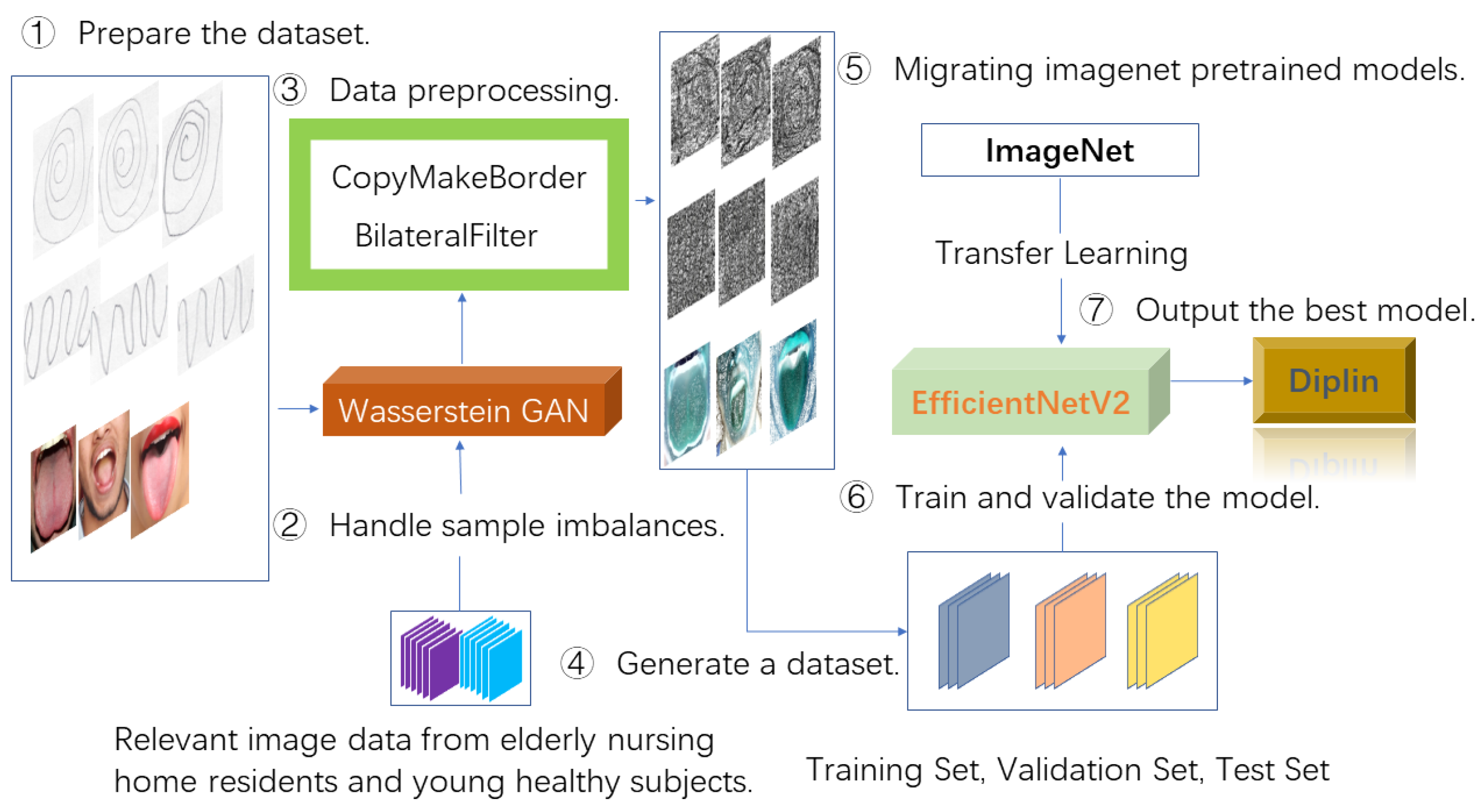
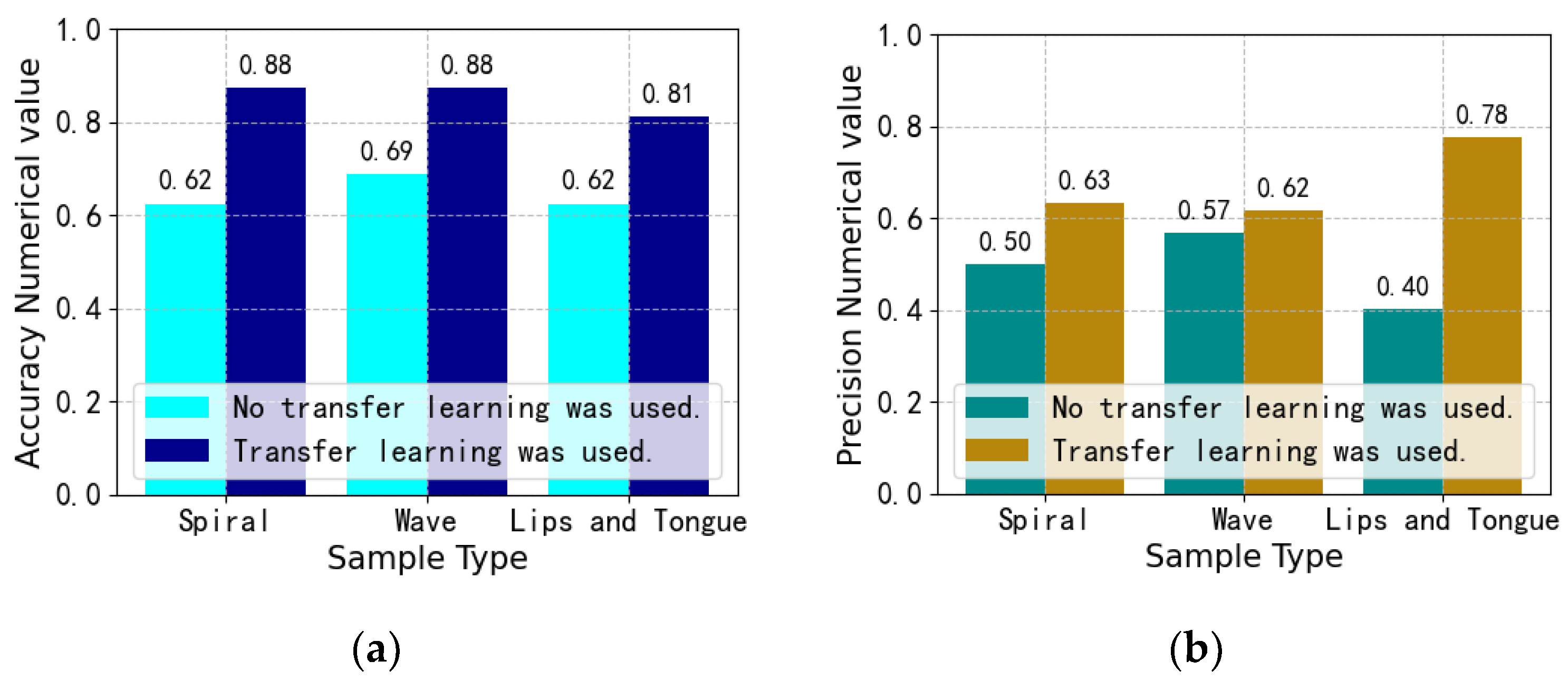
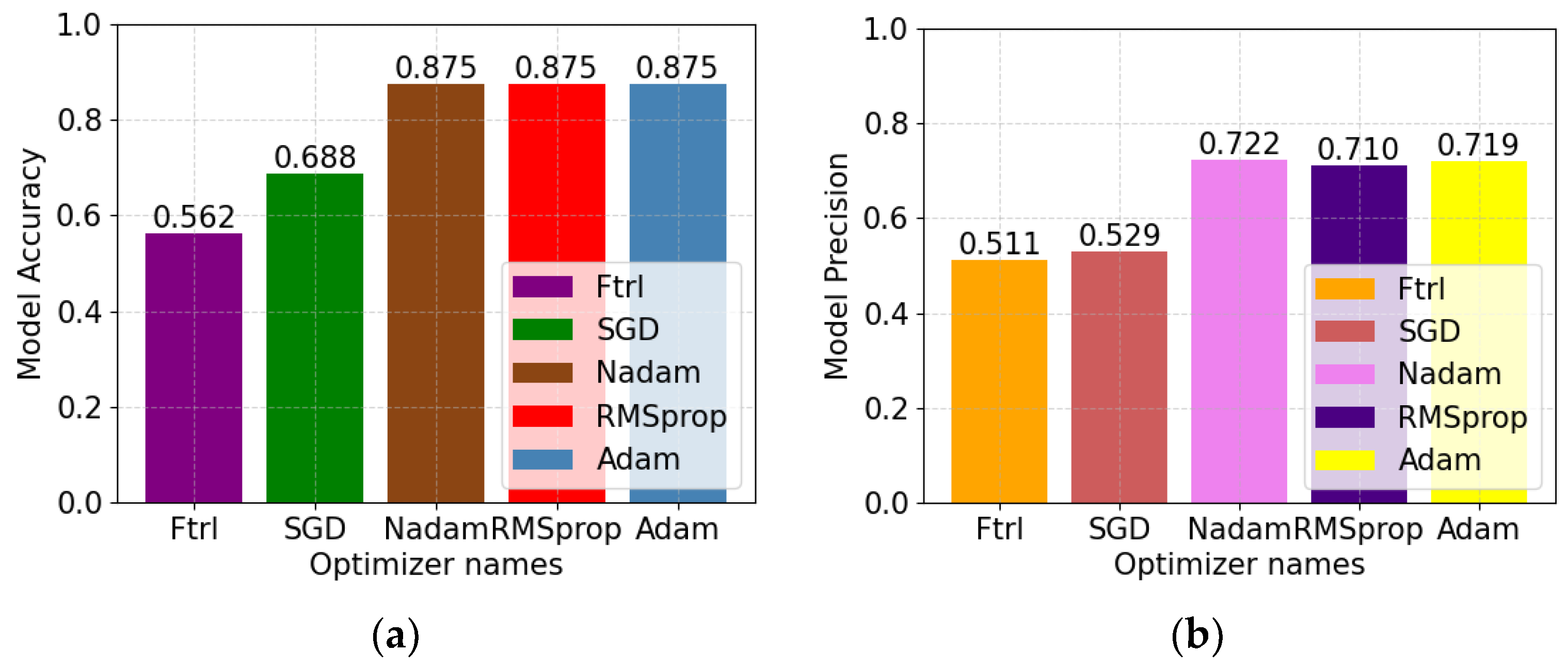
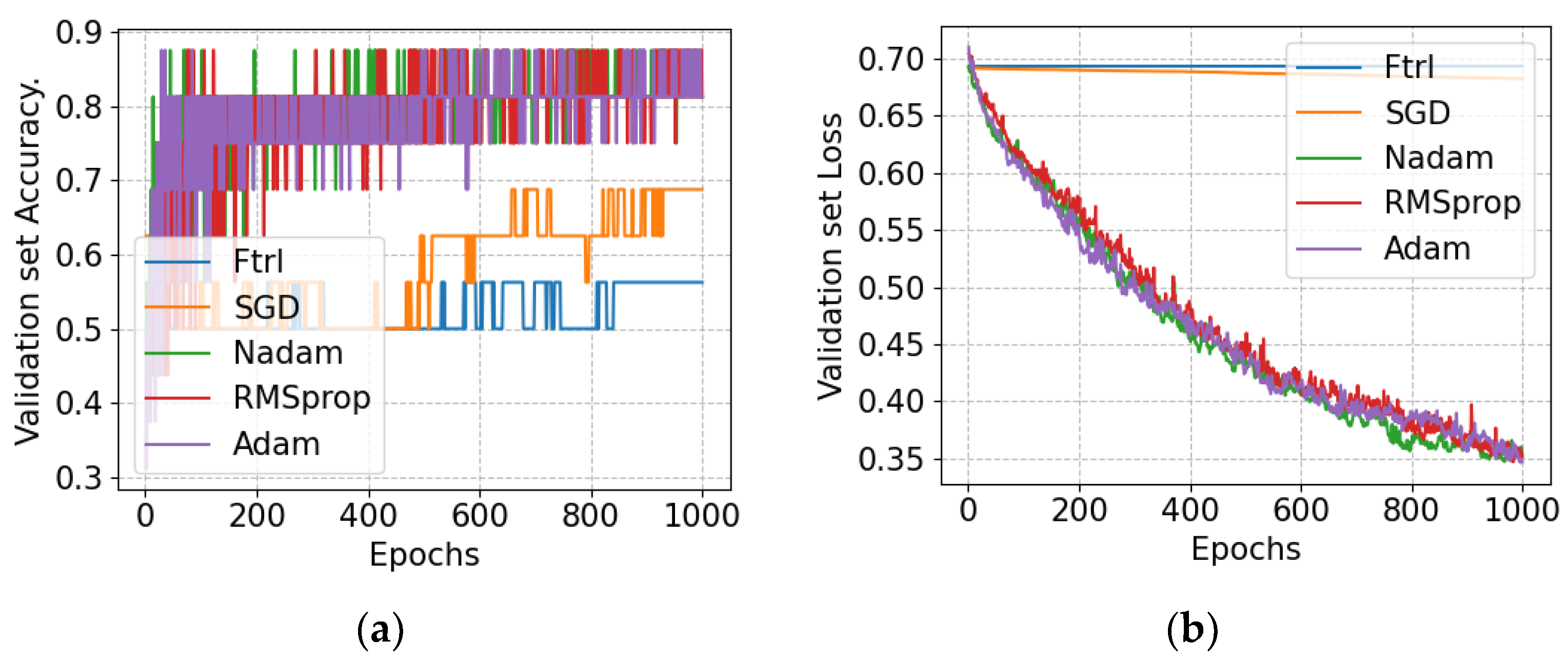

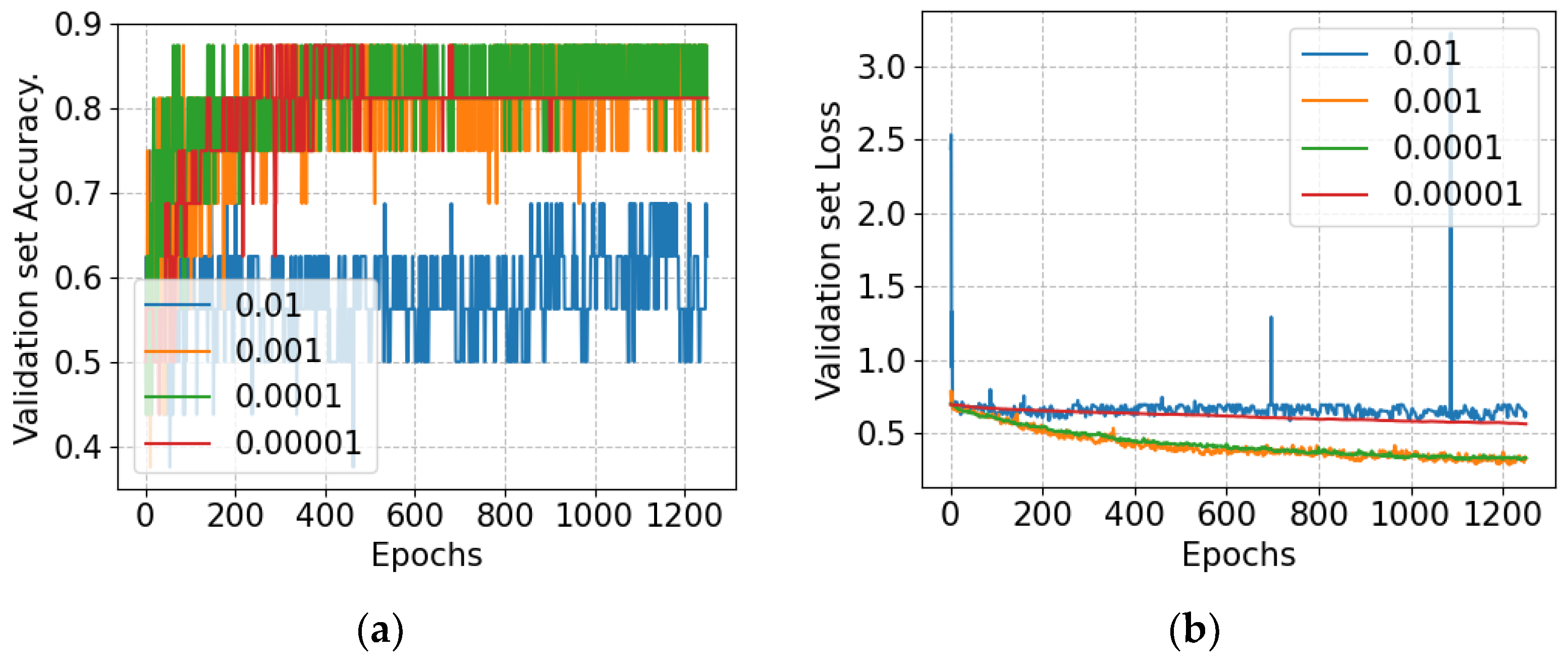
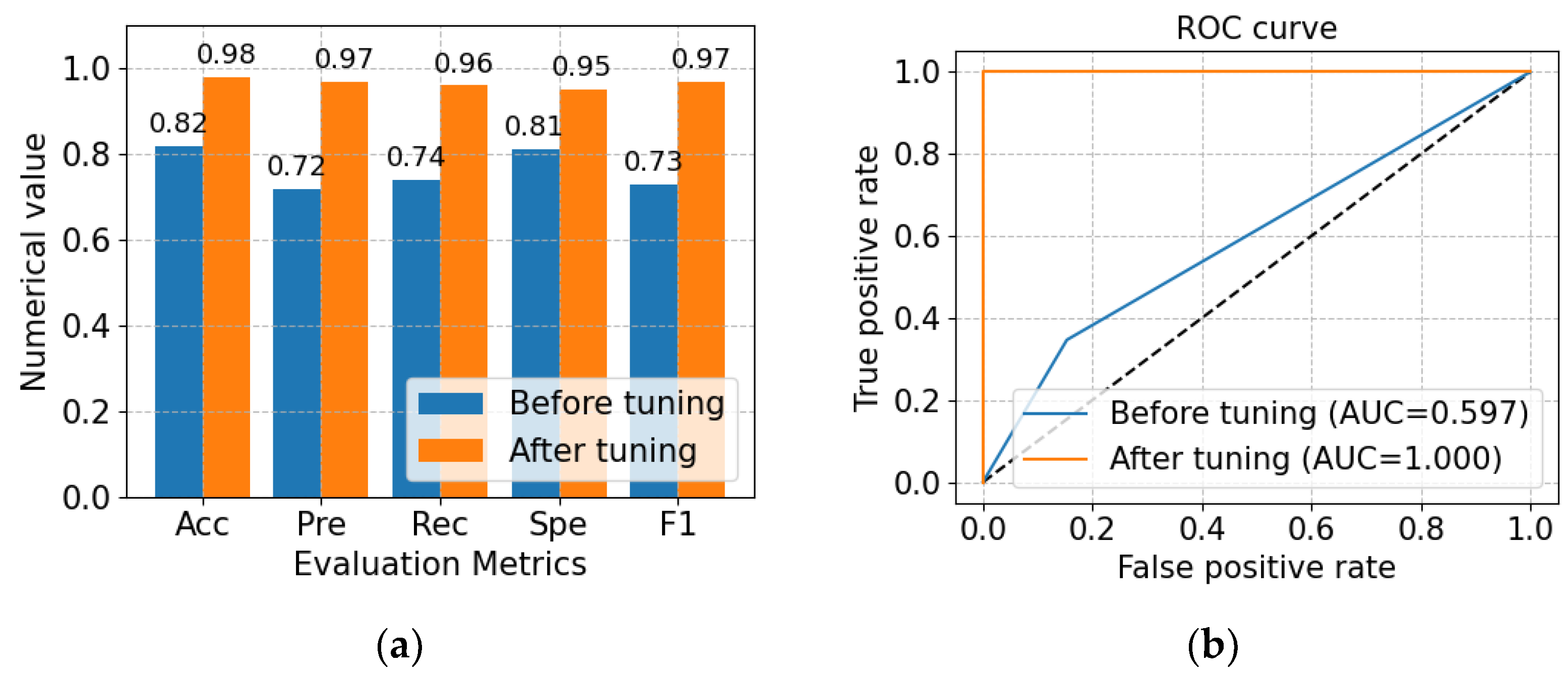

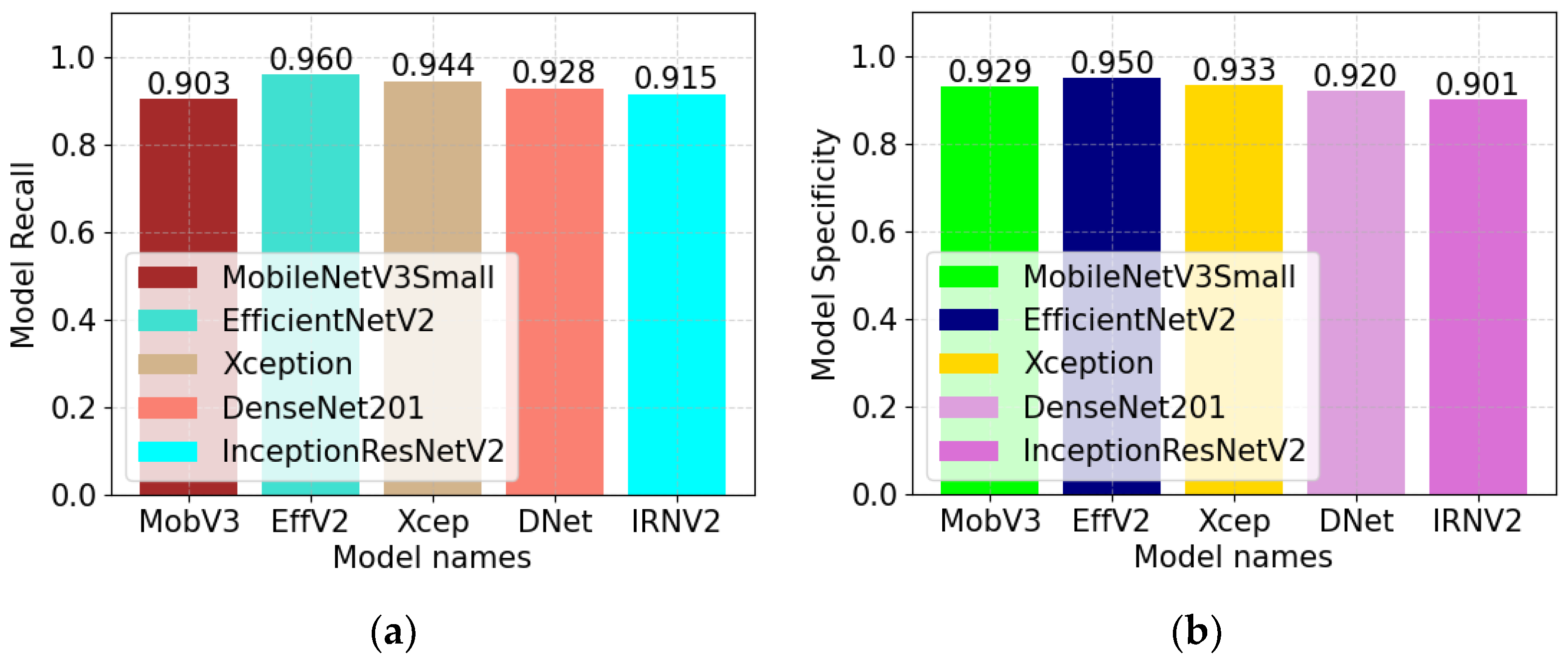
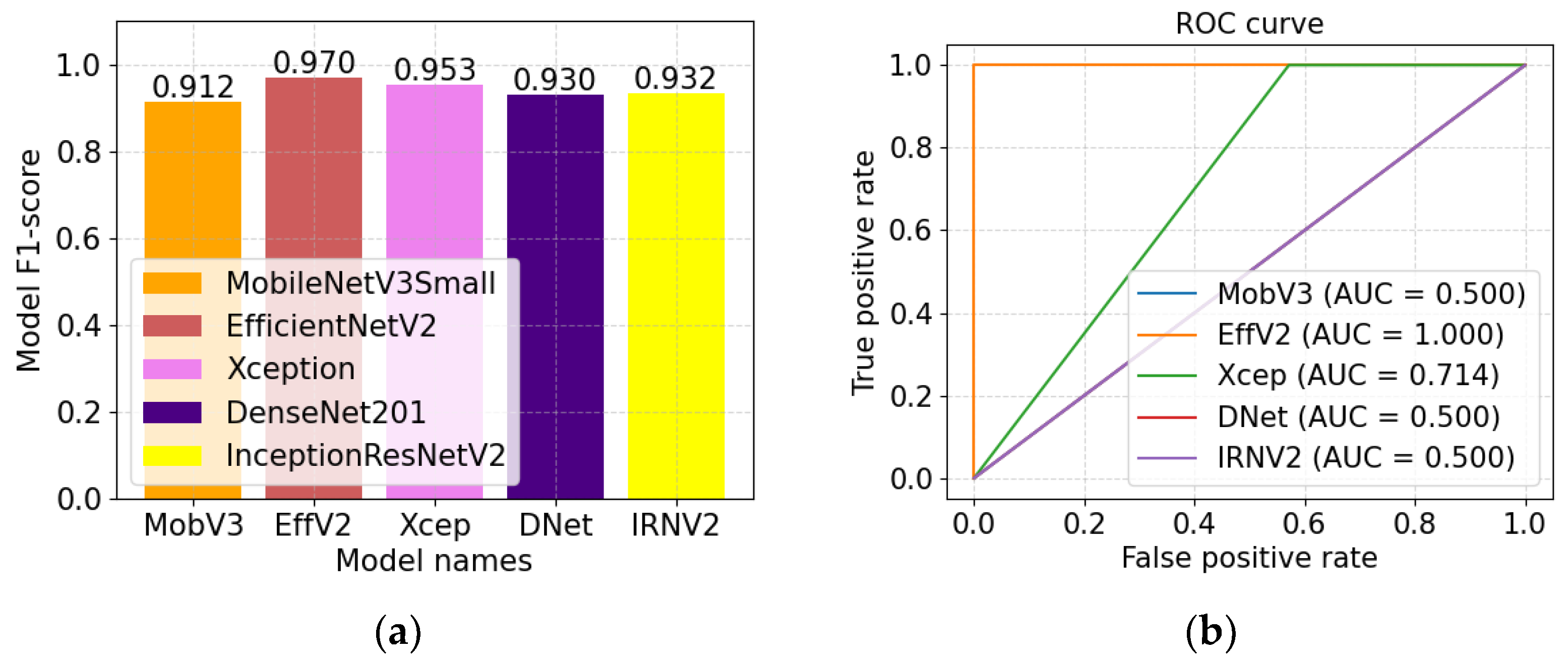
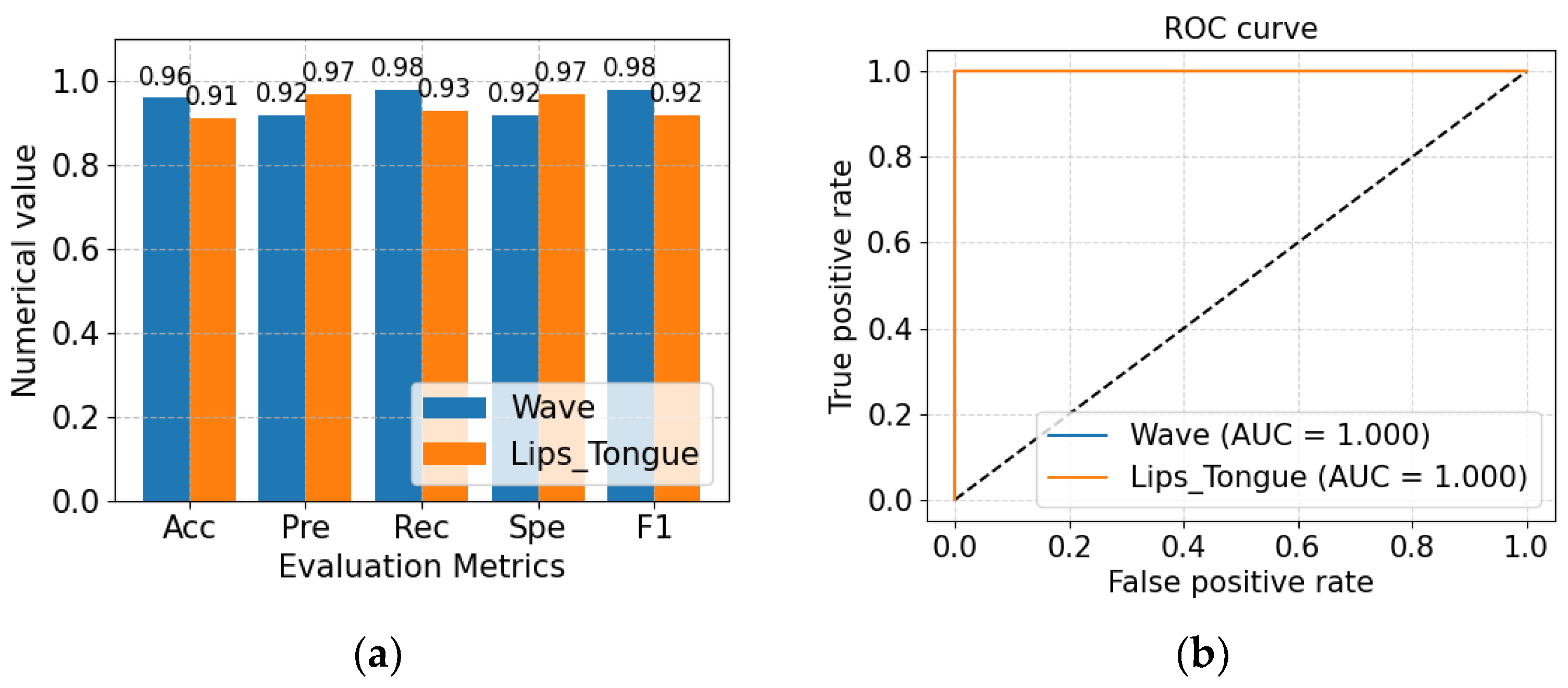
| Researcher | Disease Name | Basic Algorithm | Accuracy |
|---|---|---|---|
| Nida Khateeb [13] | heart disease | KNN | 80% |
| Allison M. Rossetto [15] | lung cancer | CNN | 85.91% |
| Hatim Guermah [20] | chronic kidney disease | SVM | 93.3% |
| Xuan Chen [21] | pancreatic cancer | ResNet18 | 91% |
| Anik Saha [24] | chronic kidney disease | Neural Networks | 97.34% |
| Md. Golam Sarowar [25] | tuberous sclerosis | CNN | 83.47% |
| Ifthakhar Ahmed [26] | myocardial infarction | CNN | 95.78% |
| Muhammad Mubashir [28] | lung cancer | CNN | 97.67% |
| N. Nemati [30] | epilepsy | CNN | 99% |
| Xiang Yu [34] | breast cancer | Resnet-50 | 95.74% |
| Researcher | Basic Algorithm | Type of Dataset | Accuracy |
|---|---|---|---|
| Satyabrata Aich [40] | DT | gait data | 81.7% |
| Terry T. Um [41] | CNN | sports data | 86.88% |
| Mehedi Masud [42] | Deep learning | audio data | 96% |
| Anshul Lahoti [43] | RNN | audio data | 83.48% |
| Ours | EfficientNetV2 | image data | 98% |
| Stage | Operator | Stride | No. Of Channels | No. of Layers |
|---|---|---|---|---|
| 0 | Conv3*3 | 2 | 24 | 1 |
| 1 | Fused-MBConv1, k3*3 | 1 | 24 | 2 |
| 2 | Fused-MBConv4, k3*3 | 2 | 48 | 4 |
| 3 | Fused-MBConv4, k3*3 | 2 | 64 | 4 |
| 4 | MBConv4, k3*3, SE0.25 | 2 | 128 | 6 |
| 5 | MBConv6, k3*3, SE0.25 | 1 | 160 | 9 |
| 6 | MBConv6, k3*3, SE0.25 | 2 | 256 | 15 |
| 7 | Conv1*1 and Pooling and FC | - | 1280 | 1 |
| Category | Category | Category | Quantity |
|---|---|---|---|
| spiral | testing | healthy | 15 |
| spiral | testing | Parkinson’s | 15 |
| spiral | training | Healthy | 36 |
| spiral | training | Parkinson’s | 36 |
| wave | testing | healthy | 15 |
| wave | testing | Parkinson’s | 15 |
| wave | training | Healthy | 36 |
| wave | training | Parkinson’s | 36 |
| Sample Type | Predicted as a Normal Sample | Predicted as an Attack Sample |
|---|---|---|
| normal sample | TN | FP |
| attack sample | FN | TP |
Disclaimer/Publisher’s Note: The statements, opinions and data contained in all publications are solely those of the individual author(s) and contributor(s) and not of MDPI and/or the editor(s). MDPI and/or the editor(s) disclaim responsibility for any injury to people or property resulting from any ideas, methods, instructions or products referred to in the content. |
© 2023 by the authors. Licensee MDPI, Basel, Switzerland. This article is an open access article distributed under the terms and conditions of the Creative Commons Attribution (CC BY) license (https://creativecommons.org/licenses/by/4.0/).
Share and Cite
Zhou, F.; Hu, S.; Wan, X.; Lu, Z.; Wu, J. Diplin: A Disease Risk Prediction Model Based on EfficientNetV2 and Transfer Learning Applied to Nursing Homes. Electronics 2023, 12, 2581. https://doi.org/10.3390/electronics12122581
Zhou F, Hu S, Wan X, Lu Z, Wu J. Diplin: A Disease Risk Prediction Model Based on EfficientNetV2 and Transfer Learning Applied to Nursing Homes. Electronics. 2023; 12(12):2581. https://doi.org/10.3390/electronics12122581
Chicago/Turabian StyleZhou, Feng, Shijing Hu, Xiaoli Wan, Zhihui Lu, and Jie Wu. 2023. "Diplin: A Disease Risk Prediction Model Based on EfficientNetV2 and Transfer Learning Applied to Nursing Homes" Electronics 12, no. 12: 2581. https://doi.org/10.3390/electronics12122581
APA StyleZhou, F., Hu, S., Wan, X., Lu, Z., & Wu, J. (2023). Diplin: A Disease Risk Prediction Model Based on EfficientNetV2 and Transfer Learning Applied to Nursing Homes. Electronics, 12(12), 2581. https://doi.org/10.3390/electronics12122581







